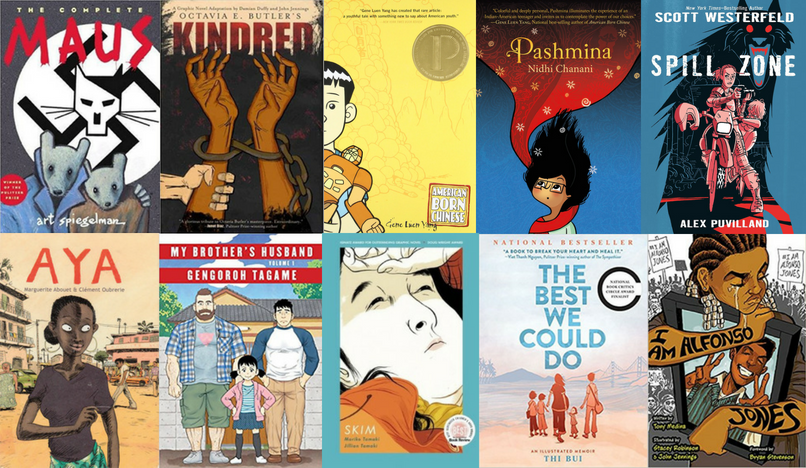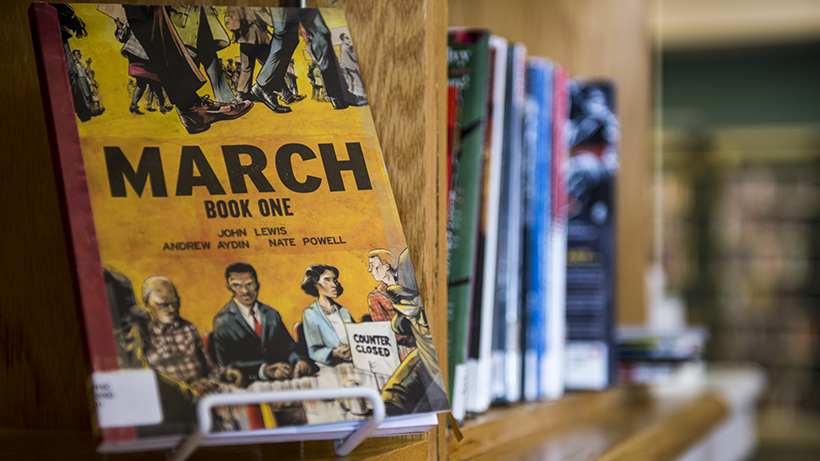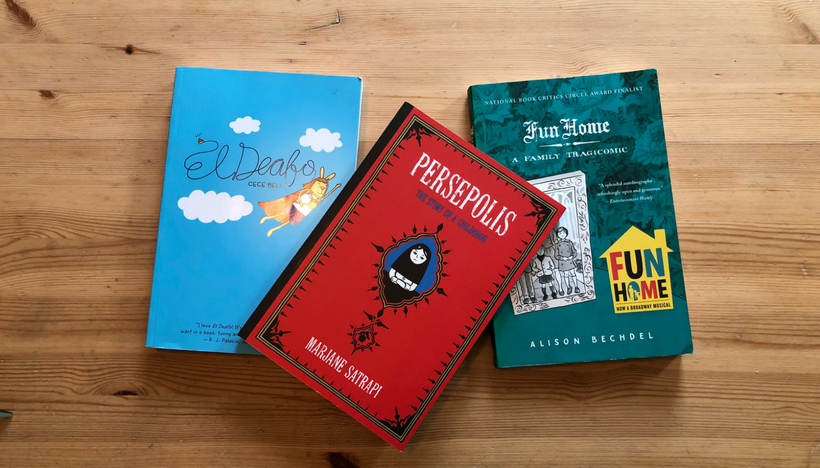Special thanks to member Laura M. Jiménez for her time and expertise in reviewing and adding additional resources for this blog post.
This summer members highlighted the need for more diversity in graphic novels. We’ve looked around the internet and compiled a list of suggested resources to check out. You will find some overlap between the titles suggested within these resources, but we’ve tried to find various lists that offer characters, authors, and illustrators from many places, with varied backgrounds, identities, and abilities.
At the end of this post, you will also find some research and additional reading on diversity and representation in graphic novels.
Book Lists
Teaching for Change carefully selects the best multicultural and social justice books for children, young adults, and educators as part of their Social Justice Books project. This graphic novel booklist is just one example of the lists available.
Each year, the Young Adult Library Services Association branch of the American Library Association announces their top graphic novels list. Check out the 2018 Top 10 list of Great Graphic Novels for Teens. You can find nominees for the 2019 list here and previous years’ lists here.
From Electric Literature’s list of 14 Diverse Graphic Novels About Coming of Age: “From an Iranian girl rebelling against the oppression of post-revolution Iran to a ‘tomboy’ refusing to conform to gender norms, these 14 graphic bildungsromans blend gorgeous artwork with the written word to create a diverse multiplicity of narratives telling of the confusion, joy, and hardship of growing up.”
On her website American Indians in Children’s Literature, NCTE member Debbie Reese compiles a list of Best Graphic Novels by Native Writers, which includes reviews that she’s published, articles about graphic novels, and links to author sites and Native bookstores.
NCTE member and graphic novel scholar Laura M. Jiménez uses critical race theory in reading and evaluating graphic novels. She shares a list of keepers on her blog.
In honor of Will Eisner Week (March 1-7), which is held to “celebrate graphic novels, sequential art, free speech, and the amazing legacy of Will Eisner, one of the most innovative figures in the history of comics and graphic novels,” the Teen Library Toolbox from School Library Journal put together a list of graphic novel titles featuring characters, authors, and illustrators from many places, with varied backgrounds, identities, and abilities.
Diversity in YA was founded in 2011 by authors Cindy Pon and Malinda Lo and celebrates young adult books about all kinds of diversity, from race to sexual orientation to gender identity and disability. These blog posts feature diverse graphic novels, including posts by the novel authors themselves.
While a bit older, this podcast from ReadWriteThink is still relevant and offers an introduction to graphic novels and some suggested titles to check out.
In this post, blogger Meet the World compiles a list of 30 diverse graphic novels that prioritize #ownvoices.
In this list from School Library Journal’s Good Comics 4 Kids, the compilers share comics and graphic novels that reflect America’s cultural diversity. Some titles address issues such as race, religion, and discrimination, while others present “diversity as a simple fact of American life.”
The Comic Book Legal Defense Fund has compiled lists of graphic novels to bring racial diversity to classrooms and libraries. Many recommendations also include suggestions on how to use the graphic novel in the classroom.
This list from the Virginia Library Association includes winners and honor books for their 2017 Graphic Novel Diversity Award.
This article from Teaching Tolerance shares recommendations for bringing Native cultures, stories, and perspectives out of the margins of your curriculum with comics by and about Native people.
Although not restricted to graphic novels, We’re the People Summer Booklist 2018 features graphic novels by #ownvoices authors that span ages and reading levels.
Research and Additional Reading
In light of the recent focus on diversity in books for youth as exemplified by movements such as “We Need Diverse Books” and “Reading Without Walls,” in “Drawing Diversity: Representations of Race in Graphic Novels for Young Adults” from School Library Research, the authors sought to understand how race is depicted in graphic novels for teens.
In this article from English Journal, Kate E. Kedley and Jenna Spiering argue that the format and content of LGBTQ graphic novels make them effective pedagogical tools for engaging students in critical discussions about gender and sexuality. By using two exemplar texts, the authors offer teachers a vocabulary and method for engaging in these conversations
In “Perspectives on Practice: Alfonso Jones Matters,” Tony Medina shares a personal narrative detailing his construction of a protagonist for a graphic novel that encapsulates the quest for justice at the heart of the Black Lives Matter movement.
To better understand the creation and philosophy behind the #ownvoices movement in children’s and young adult literature, you should read Corinne Duyvis’s blog post about how and why she proposed the hashtag.
Ellen Oh, one of the founders of We Need Diverse Books, has an interview on the Reading While White blog on the creation and ongoing work of the organization. They are truly trying to change the face of publishing.
Research by Laura M. Jiménez found that comprehending graphic novels requires some unique reading skills. Just as with other forms and genres, graphic novel reading comprehension should be taught in order for students to have access to all that this complex form has to offer. This Reading Teacher article shows teaching and learning with graphic novels in a classroom.



